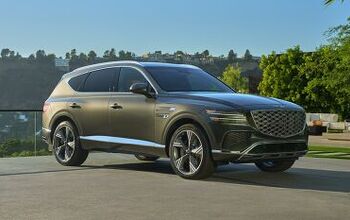Senate Finance Committee Approves $12,500 EV Tax Credit Bill

On Wednesday, the Senate Finance Committee advanced the Clean Energy for America Act making a few tweaks from earlier proposals. Changes include raising the federal EV tax rebate ceiling to $12,500 and opening the door for automakers who already exhausted their production quotas.
It’s good news for General Motors, which recently begged the government for just such a handout. But any manufacturer participating in the sale of electric vehicles will find themselves similarly blessed by the updated rules — assuming they make it through the halls of Capitol Hill with the necessary support.
Let’s take a peek behind the curtain to see what the updated proposal entails.
While the $7,500 tax credit persists, the bill now adds special exemptions depending on how the vehicle is manufactured For example, the government will tack on another $2,500 if final assembly takes place inside the United States and another $2,500 if the factory in question happens to be represented by a union. While the latter inclusion seems concerningly political, there doesn’t appear to be any language stipulating whether not it matters if unionized plants have to be located in the country for the vehicle to be eligible.
It’s also probably one of the biggest reasons why the committee advanced the legislation on a tie split evenly (14-14) along party allegiances. But the rules say the bill only gets the kibosh if it loses the vote, so the deadlock still means it can be sent all the way to the Senate. But some of the particulars might make its pathway there incredibly difficult.
Perhaps the most fiscally irresponsible aspect of the proposal involves ending any caps on vehicle production. Early incarnations of the EV tax credit were intended only to get the ball rolling on alternative energy vehicles, so they would gain public acceptance. But the Clean Energy for America Act will continue issuing credits until electric vehicles become over half of a company’s annual sales. Even then, there will be a phase-out period where rebates would be scaled back over two years — similar to how things work under the current rules.
This is an insane amount of money for any government to effectively hand over to automotive manufacturers with no definitive end date. We have no real way of knowing when EVs will supplant the internal combustion engine as the dominant powertrain. These subsidies could last for decades, extending well beyond the point where electrically driven cars reach financial parity with ICEs. They also won’t be linked to the Biden infrastructure plan, which is striving to create $100 billion in additional rebates for electric cars.
Let’s not forget all this money is supposed to be coming from America’s tax base and there’s literally no way to even begin estimating what the total cost will be.
The Clean Energy for America Act basically throws any notion of there being a free auto market out the window. It incentives the building and purchase of EVs to such a degree that there would be little reason to continue pursuing gasoline or diesel development. Even they were suddenly proven to be better for the environment or consumers than plug-ins, the payout for running with EVs would still be far too big to ignore. I believe the correct term for this is a “planned economy,” as it technically shapes/restrains existing consumer demand in favor of greater capital investments for economic development in a manner that suits government goals.
In fact, the only aspect of the proposal that seems to exercise any financial restraint is the MSRP eligibility limit of $80,000. This is designed to prohibit wealthy individuals from taking advantage of the federal tax credits. However, most high-end electrics currently on the market already come in below the cutoff — including the Porsche Taycan and Tesla Model S.
[Image: Nmorguelan/Shutterstock]

A staunch consumer advocate tracking industry trends and regulation. Before joining TTAC, Matt spent a decade working for marketing and research firms based in NYC. Clients included several of the world’s largest automakers, global tire brands, and aftermarket part suppliers. Dissatisfied with the corporate world and resentful of having to wear suits everyday, he pivoted to writing about cars. Since then, that man has become an ardent supporter of the right-to-repair movement, been interviewed on the auto industry by national radio broadcasts, driven more rental cars than anyone ever should, participated in amateur rallying events, and received the requisite minimum training as sanctioned by the SCCA. Handy with a wrench, Matt grew up surrounded by Detroit auto workers and managed to get a pizza delivery job before he was legally eligible. He later found himself driving box trucks through Manhattan, guaranteeing future sympathy for actual truckers. He continues to conduct research pertaining to the automotive sector as an independent contractor and has since moved back to his native Michigan, closer to where the cars are born. A contrarian, Matt claims to prefer understeer — stating that front and all-wheel drive vehicles cater best to his driving style.
More by Matt Posky
Latest Car Reviews
Read moreLatest Product Reviews
Read moreRecent Comments
- El scotto No rag-top, no rag-top(s) = not a prestigious car brand. Think it through. All of the high-end Germans and Lexus have rag-tops. Corvette is really its own brand.World-leading engines. AMG, M, S and well Lexus is third-world tough. GM makes one of the best V-8s in the world in Bowling Green. But nooooo, noooo, we're GM only Corvettes get Corvette engines. Balderdash! I say. Put Corvette engines in the top-tier Cadillacs. I know GM could make a world-class 3.5 liter V-6 but they don't or won't. In the interior everything that gets touched, including your butt, has to feel good. No exceptions.Some think that those who pay above MSRP and brag about it are idiots. Go the opposite direction, and offer an extended 10-year 100,000-mile factory warranty. At a reasonable price. That's Acura's current business model.
- Carrera 2014 Toyota Corolla with 192,000 miles bought new. Oil changes every 5,000 miles, 1 coolant flush, and a bunch of air filters and in cabin air filters, and wipers. On my 4th set of tires.Original brake pads ( manual transmission), original spark plugs. Nothing else...it's a Toyota. Did most of oil changes either free at Toyota or myself. Also 3 batteries.2022 Acura TLX A-Spec AWD 13,000 miles now but bought new.Two oil changes...2006 Hyundai Elantra gifted from a colleague with 318,000 when I got it, and 335,000 now. It needed some TLC. A set of cheap Chinese tires ($275), AC compressor, evaporator, expansion valve package ( $290) , two TYC headlights $120, one battery ( $95), two oil changes, air filters, Denso alternator ( $185), coolant, and labor for AC job ( $200).
- Mike-NB2 This is a mostly uninformed vote, but I'll go with the Mazda 3 too.I haven't driven a new Civic, so I can't say anything about it, but two weeks ago I had a 2023 Corolla as a rental. While I can understand why so many people buy these, I was surprised at how bad the CVT is. Many rentals I've driven have a CVT and while I know it has one and can tell, they aren't usually too bad. I'd never own a car with a CVT, but I can live with one as a rental. But the Corolla's CVT was terrible. It was like it screamed "CVT!" the whole time. On the highway with cruise control on, I could feel it adjusting to track the set speed. Passing on the highway (two-lane) was risky. The engine isn't under-powered, but the CVT makes it seem that way.A minor complaint is about the steering. It's waaaay over-assisted. At low speeds, it's like a 70s LTD with one-finger effort. Maybe that's deliberate though, given the Corolla's demographic.
- Mike-NB2 2019 Ranger - 30,000 miles / 50,000 km. Nothing but oil changes. Original tires are being replaced a week from Wednesday. (Not all that mileage is on the original A/S tires. I put dedicated winter rims/tires on it every winter.)2024 - Golf R - 1700 miles / 2800 km. Not really broken in yet. Nothing but gas in the tank.
- SaulTigh I've got a 2014 F150 with 87K on the clock and have spent exactly $4,180.77 in maintenance and repairs in that time. That's pretty hard to beat.Hard to say on my 2019 Mercedes, because I prepaid for three years of service (B,A,B) and am getting the last of those at the end of the month. Did just drop $1,700 on new Michelins for it at Tire Rack. Tires for the F150 late last year were under $700, so I'd say the Benz is roughly 2 to 3 times as pricy for anything over the Ford.I have the F150 serviced at a large independent shop, the Benz at the dealership.


































Comments
Join the conversation
slavuta, Please don't tell me they bought Joey B's money printing press.
Electric cars, especially Tesla vehicles are definitely superior to Gas powered cars. There's a reason why Tesla sales have been DOUBLING every single year for the past 10 years. I can easily see Tesla going from 500K sales last year to over a Million sales this year WITH OR WITHOUT this incentive. As for reaching parity, there's already parity when the Tesla Model 3 costs less to own over 5 years than a Toyota Camry. Why? No need to worry about Gas every day, Oil Changes every 3 months, Brakes every year and so on and so forth. This rebate is unnecessary and it's unlikely that Tesla will be able to more than double annual sales. What they really should do is end subsidies to Oil companies and refineries. End subsidies for Ethanol and other fuel additives.